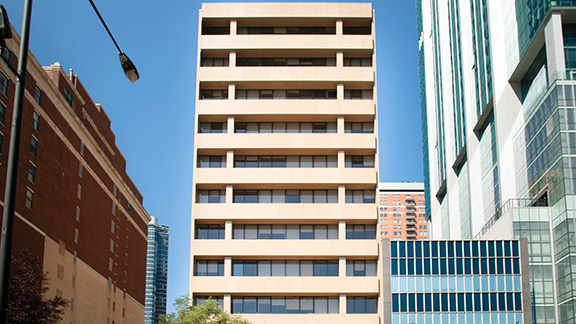Making History—and a Landmark
In 1969, when John H. Johnson needed a new headquarters for Johnson Publishing Company—publisher of iconic titles such as Ebony and Jet and an integral part of Black life in the twentieth century—he approached Ludwig Mies van der Rohe protégé John Warren Moutoussamy (ARCH ’48) to create the new home for his publishing juggernaut.
Moutoussamy had already established himself as one of Chicago’s leading architects, becoming the first Black partner at a major firm–Dubin, Dubin, Black and Moutoussamy–and having designed a series of high-rise apartment buildings, Lawless Gardens, in Bronzeville. But the 11-story Johnson Publishing remains one of Moutousammy’s greatest legacies, and it is the first and only downtown Chicago high-rise designed by a Black architect.
“It’s really a great building architecturally. The north and south exterior walls are solid, but aren’t load bearing. [Moutoussamy] uses columns running up the front of the building, and cantilevers the floors outward,” says architectural writer, photographer, and College of Architecture adjunct faculty member Lee Bey.
“Then you get into the history of the building and its value only increases,” Bey continues. “Johnson built the building at the peak of his powers, and it showcases how successful his media empire had become. Most media never told stories of Black people, or gave them little attention when they did. Johnson told those stories, and chronicled Black achievement and became wildly successful. The building—built on one of Chicago’s most famous streets—underscores that success and the importance of Black people and Black stories.”
Moutoussamy’s modernist concrete, marble, and glass design was integral to the identity of Johnson Publishing, whose logo along with those of Ebony and Jet adorned the top of the building. The interior, designed by Arthur Elrod and William Raiser, was characterized by bright colors and patterns, and filled with custom furniture and African art. Though Johnson Publishing had previously operated out of many rehabbed buildings since its founding in 1942, the high-rise at 820 South Michigan Avenue was distinctly its own.
“This new building reflects our faith in the strength and vitality of that long line of Black men and women who have contributed so much to this country and this community,” Johnson said at the time of the building’s opening in 1972. “It is a poem in glass and marble which symbolizes our unshakeable faith that the struggles of our forefathers were not in vain and that we shall indeed overcome.”
“This new building reflects our faith in the strength and vitality of that long line of Black men and women who have contributed so much to this country and this community,”
—John M. Johnson
The high-rise was home to Johnson Publishing until 2010, when the publisher sold the building to Columbia College Chicago, which intended to transform it into a combination library and student center. When the project lost steam, Columbia started advertising the building for sale in 2016, putting its future into question.
But in February 2017 efforts to save the building from possible demolition were set in motion. Then-mayor Rahm Emanuel had announced that the building would be considered for landmark designation, and the designation, co-sponsored by 4th Ward Alderman Sophia King, was put before City Council in November of that year. It passed unanimously.
The same year, 3L Real Estate acquired the building from Columbia with the intent to turn it into an apartment building. Given the building’s newly minted landmark status, 3L was required to keep the exterior intact including the sign featuring the company logos; the landmark status, however, didn’t protect its bright interior elements, though some pieces, such as swatches of the bold carpet, were saved and put on display.
Summer 2020 marks a year since the building found new life as an apartment complex. It is one of many modernist buildings in Chicago finding new life through adaptive reuse. Although the building is no longer used for its intended purpose and the iconic interiors are gone, by preserving the exterior, Chicago is safeguarding both a part of the Johnson Publishing legacy and the work of a pioneering Black architect.
“I believe it is better to see buildings change their original functions instead of seeing them torn down,” says College of Architecture professor and architectural historian Michelangelo Sabatino. “Significant buildings like the Johnson Publishing [Company] Building tell stories about the ways in which people lived and worked. When we tear them down, we erode a part of our collective memory.”

Significant Features
During the landmarking process, the Commission on Chicago Landmarks is required to identify key architectural features deemed to be significant. The commission identified the following three:
- All exterior façades and rooflines of the building are visible from public rights-of-way.
- The rooftop sign shows the iconic Johnson Publishing Company, Ebony, and Jet logos.
- The east-facing face of the building is considered “primary” because of its visibility and because it makes up the bulk of the building’s architectural expression and character.
